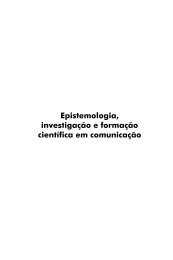Virtual Methods
Virtual Methods
Virtual Methods
You also want an ePaper? Increase the reach of your titles
YUMPU automatically turns print PDFs into web optimized ePapers that Google loves.
232 • References<br />
Singh, S. (2001), ‘Gender and the Use of the Internet at Home’, New Media and<br />
Society, 3(4): 395–416.<br />
Skupin, A. and Fabrikant, S. I. (2003), ‘Spatialization <strong>Methods</strong>: A Cartographic<br />
Research Agenda for Non-Geographic Information Visualization’, Cartography<br />
and Geographic Information Science, 30(2): 95–115.<br />
Slater, D. (2002a), ‘Social Relationships and Identity Online and Offline’, in<br />
L. Lievrouw, & S. Livingstone (eds), The Handbook of New Media, London:<br />
Sage, pp. 533–546.<br />
—— (2002b), ‘Making Things Real: Ethics and Order on the Internet’, Theory,<br />
Culture & Society, 19(5–6): 227–46.<br />
Smith, A. G. (1999), ‘A Tale of Two Web Spaces: Comparing Sites Using Web<br />
Impact Factors’, Journal of Documentation, 55(5): 577–92.<br />
Smith, G. W. H. (ed.) (1999), Goffman and Social Organization, London and New<br />
York: Routledge.<br />
—— (2001), ‘Techniques of Neutralization, Techniques of Body Management and<br />
the Public Harassment of Runners’, in S. Cunningham-Burley and K. Backett<br />
(eds), Exploring the Body, Basingstoke: Palgrave, pp. 163–182.<br />
Smith, M. (1998), ‘Invisible Crowds in Cyberspace: Measuring and Mapping the<br />
Social Structure of Usenet’, in M. Smith and P. Kollock (eds), Communities in<br />
Cyberspace, New York: Routledge, pp. 195–219.<br />
—— (2002), ‘Tools for Navigating Large Social Cyberspaces’, Communications<br />
of the ACM, 45(4): 51–5.<br />
Snowdon, D. N., Churchill, E. F. and, Frécon, E. (2003), Inhabited Information<br />
Spaces: Living with your Data, London: Springer.<br />
Sparke, M. (1998), ‘A Map that Roared and an Original Atlas: Canada,<br />
Cartography, and the Narration of Nation’, Annals of the Association of<br />
American Cartographers, 88(3): 463–95.<br />
Spears, R. and Lea, M. (1992), ‘Social Influence and the Influence of the Social in<br />
Computer-Mediated Communication’, in M. Lea (ed.), Contexts in Computer-<br />
Mediated Communication, London: Harvester Wheatsheaf, pp. 30–64.<br />
Spears, R. Lea, M., & Lee, S. (1990), ‘De-Individuation and Group Polarization in<br />
Computer-Mediated Communication’, British Journal of Social Psychology.<br />
29(2): 121–34.<br />
Spears, R., Postmes, T., Lea, M. and Wolbert, A. (2002), ‘When are Net Effects<br />
Gross Products? The Power of Influence and the Influence of Power in<br />
Computer-Mediated Communication’, Journal of Social Issues, 58(1): 91–107.<br />
Speed, G. J. (1893), ‘Do Newspapers Now Give the News?’, Forum, 15, 705–11.<br />
Spender, D. (1995), Nattering on the Net, North Melbourne: Spinifex.<br />
Sproull, L. & Kiesler, S. (1986), ‘Reducing Social Context Cues: Electronic Mail<br />
in Organizational Communication’, Management Science, 32(11): 1,492–512.<br />
Sproull, L. and Kiesler, S. (1991), Connections: New Ways of Working in the



